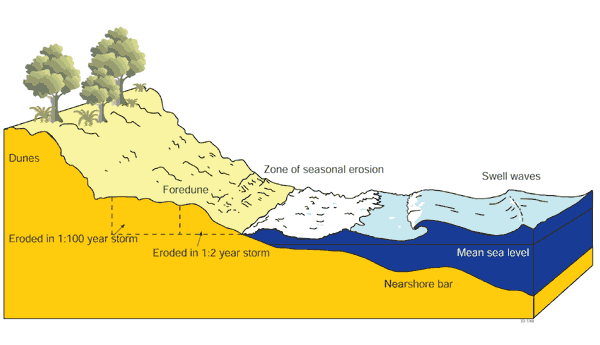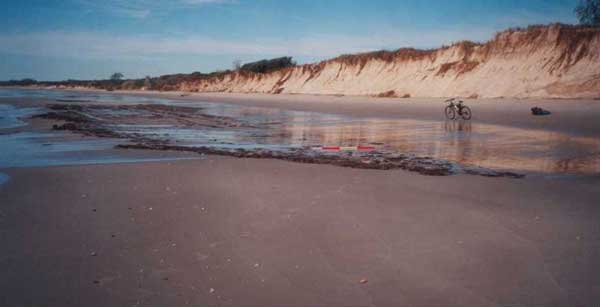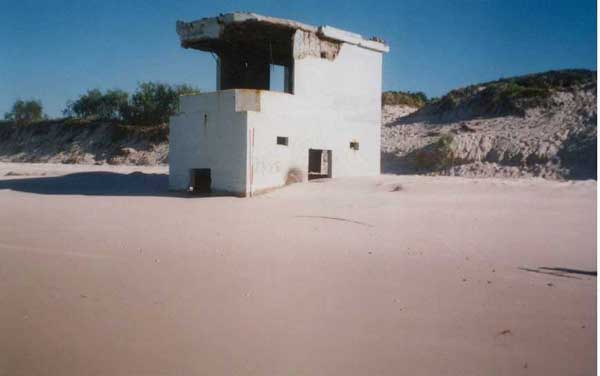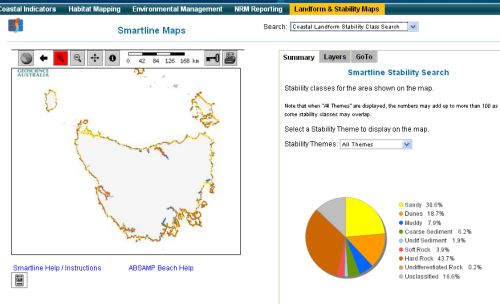Geological background
Beach deposits predominantly consist of sand particles that can be easily eroded by waves. These deposits comprise terrestrial sediment delivered to the coast by rivers, sediment produced by the erosion of coastal landforms by waves, and marine sediment that has been reworked from offshore deposits onto the coast. Sand derived from a terrestrial source is usually dominated by resistant minerals such as quartz. Marine sediments, however, comprise resistant minerals and biogenically-produced calcium carbonate.
The sand in many Australian beach systems is at least partially sourced from the continental shelf. Large volumes of this inner shelf sand have been pushed up the continental shelf as sea level rose following the end of the last glacial period (18,000 years ago), and has been accumulating on the present coast during the last 6,500 years of high and relatively stable sea level 1. On the southeast coast of Australia, large bodies of sand on the inner shelf are the remnants of coastal sand deposits emplaced when sea level was a few tens of metres lower than present 1. The rate of supply of sediment derived from the inner continental shelf varies between coastal regions, and in some has declined over the last few thousand years because over this period the volume of sediment available for reworking to the coast by wave-induced currents has gradually been reduced1.

Figure 1. Cross-section of a sandy beach showing the significant difference in the volume of sediment eroded in high-magnitude storms (1:100 year) compared to seasonal erosional events.
Beaches may also be linked to offshore sources of biogenic sediment such as coral and algal reefs in the tropics and subtropics, and molluscan and bryozoan banks in temperate regions. The long-term supply of sediment to these beaches can be relatively constant2.
Many beach systems in the more humid regions of Australia are supplied with sediment from rivers. This fluvial sediment is often transported in an along-shore pathway away from the mouth of the river. The supply of this sediment to beaches may be constant in the long term but can be affected by climate change and catchment modification by humans. The volume of fluvial sediment supplied to beaches, however, may be quite small compared to the volume being moved to the coast because sediment is often trapped in tide-dominated and wave-dominated estuaries, which act as sediment sinks.
On coasts where the shoreline configuration is highly irregular, long headlands and reefs can trap sediment delivered to the shore by rivers within an embayment (e.g., south coast of NSW). As a consequence, sediment is not moved along the coast by waves and currents but remains within the embayment, forming a compartmentalised beach sediment system. In contrast, in regions with a more regular coastline, sand can be transported many hundreds of kilometres along the coast by oblique waves and shore parallel currents, forming a corridor of sediment transportation (e.g. northern coast of NSW, SE Queensland).

Photo 1. Beach erosion at Bribie Island, SE Qld, in April 2002 exposed relict estuarine sediments in the intertidal zone and cut back the foredune by several metres (Photo by J. Lester).

Photo 2. Long-term erosion of the beach on the spit at the northern end of Bribie Island, SE Qld. This WWII gun bunker was originally built behind the beach on the foredune, which now sits behind the bunker. (Photo by J. Lester).
Natural cycles of erosion and accretion
Sandy beaches are dynamic sedimentary systems that naturally experience phases of erosion and accretion that operate over a range of time intervals3. Frequent short-term changes are seasonal – erosion mostly occurs in seasons when storms that generate erosional wave regimes are more frequent. Rapid erosional episodes may also be produced by high-magnitude storms, such as tropical cyclones or intense low pressure systems in temperate regions. The degree of erosion that occurs within a particular erosional phase can be highly variable, and this likewise is linked to the magnitude and frequency of storms that impact on the coast. For example, during a 1 in 100 year high magnitude storm, waves may erode several metres into the foredune that sits well behind the normally active zone of accretion and erosion. Also, several lower-magnitude storms that occur in quick succession can produce a similar degree of erosion because the intervening periods are too short for constructive swell waves to push a significant amount of sediment back to the shoreline.
The accretion of sand on beaches occurs during the more quiescent seasons when average swell waves deliver sediment back to the shoreline. Beach accretion, however, is generally a much slower process than beach erosion. For example, it may take several years for a beach to return to its pre-storm condition after one major storm or several smaller storms in quick succession3.
Longer erosional phases are linked to climatic cycles such as the Southern Oscillation 456. For example, erosional phases are correlated with La Nina events, which are years when there is a higher frequency of storms along the east coast of Australia. Alternatively, phases of positive sediment budget, when there is a lower frequency of coastal storms, are linked to the El Nino events. Fluctuations in beach morphology, from erosional to accretional forms, also operate over longer time intervals because the frequency of El Nino and La Nina events fluctuates over decadal periods. Long term trends in beach morphology are also related to changes in sea level, which can induce phases of erosion (rising sea level) and accretion (falling sea level).
Human activities that accelerate beach erosion
1. Coastal development
The main pressures on beaches and dunes are urbanisation and developments associated with coastal tourism7. Most of Australia’s major urban centres are located in coastal regions and much recent development has occurred along the coast itself. Major erosion problems have occurred where buildings have been erected on parts of a sandy beach system that are subject to natural phases of erosion, especially where the variations in beach morphology are linked to the longer cyclical changes in climate. Also, on many developed coasts modifications to the shoreline configuration, such as breakwaters, groynes and retaining walls, have disrupted the natural sediment transport pathways and created problems by starving sections of coast of sand. These sections then become more susceptible to erosion as the rate of sediment delivery falls short of the rate of loss. Likewise, the damming of rivers has also likely reduced the volume of sediment they deliver to the coast and, therefore, the rate of sediment delivered to beaches linked to terrestrial sources of sediment.
2. Climate change related to global warming
An increase in the frequency of major coastal storms or a rise in relative sea level can accelerate shoreline erosion and also trigger the erosion of dunes immediately behind the beach.
In Landform and Stability module, the coast is digitally mapped as a single line (Smartline) which has segmentations in the alongshore direction marking significant changes in coastal landform types and landform stability classifications. The landform stability classifications describe the sensitivity of the coast to the potential impacts of climate change and sea-level rise, including shoreline erosion.

Figure 4. Example output from the stability line maps
3. Removal of dune vegetation
The loss of protective vegetation is a major trigger for dune erosion. This can be induced by grazing, fires, tracks (four-wheel drives, motor bikes, horses) and even foot traffic, and can exacerbate beach erosion 8.
Relevant indicators
Changes in the following parameters may indicate that a beach is being eroded or is at risk for erosion:
- a reduction in beach and dune areas (measured by remote sensing techniques);
- a reduction in protective vegetation on dunes9;
The cost of beach rehabilitation can be estimated from:
- the number and dollar costs of beach nourishment programs9; and
- the number and and dollar costs of stabilisation works (e.g. walls, groynes and ramparts)9.
More information
NSW Government. Office of Environment & Heritage – Coastal Management, 2003.
Western Australia Government, 2003. https://catalogue.data.wa.gov.au/.
UNESCO, 2003, Coping with beach erosion.
USGS, 2003. News and information on El Nino.
More information on habitat removal/disturbance.
Author
Brendan Brooke, Geoscience Australia
- Roy, P.S., Cowell, P.J, Ferland, M.A. and Thom, B.G., 1994. Wave dominated coasts. In: Carter, R.W.G. and Woodroffe, C.D., (Eds.), Coastal Evolution. Cambridge University Press, Cambridge, pp 121-186 ↩ ↩ ↩
- Murray-Wallace, C.V., Banerjee, D., Bourman, R.P., Olley, J.M., and Brooke, B.P., 2002. Optically stimulated luminescence dating of Holocene relict foredunes, Guichen Bay, South Australia. Quaternary Science Reviews 21, 1077-1086 ↩
- Thom, B.G. and Hall, W. 1991. Behaviour of beach profiles during accretion and erosion dominated periods. Earth Surface Processes and Landforms 16, 113-127. ↩ ↩
- Bryant, E.A., 1985. Rainfall and beach erosion relationships, Stanwell Park, Australia, 1895-1980: worldwide implications for coastal erosion. Zeitschrift fur Geomorphologie Supplementband 57, 51-66. ↩
- Bryant, E.A. 1988 The effect of storms on Stanwell Park, N.S.W. beach position, 1943-1980. Marine Geology 79, 171-187. ↩
- Short, A.D., and Trembanis, A. 2000. Beach oscillation, rotation and the Southern Oscillation, Narrabeen Beach, Australia. Proceedings of the 27th International Conference on Coastal Engineering. Sydney 16-21, July 2000, Vol. 1, Paper no. 4 ↩
- Australian State of the Environment Committee. 2001. Coasts and Oceans: State of the environment Report 2001. CSIRO Publishing. Collingwood. ↩
- NSW DLWC 2001, Coastal Dune Management, NSW Department of Land and Water Conservation, Newcastle, pp. 96. ↩
- Ward, T., Butler, E. and Hill, B. 1998. Environmental Indicators for National State of the Environment Reporting, Estuaries and the Sea, Commonwealth of Australia, pp. 81. ↩ ↩ ↩


